Projects
Here's a list of our projects which have either been tested already or where PCBs are already on their way to our workshop. We haven't published schematics/layouts/CAD drawings for some projects yet because we don't feel comfortable releasing them when we're not 100% sure yet that they all work as advertised. If you're still interested, feel free to contact us and we'll send them to you.
Akupakk

Fast-charge battery pack for small traction applications
The Akupakk Project was designed to be utilised in a small semi-autonomous vehicle operating in sub-zero (Celsius that is) temperatures. It features LiFeYPo4 cells with 40Ah each in a 12S configuration. It is designed to be fast-charged with up to 120A to reduce the charging time to ~30min.
It consists of a Green Mantis BMS and two Restless Raccoon DC/DC converter modules (not pictured here).
Green Mantis
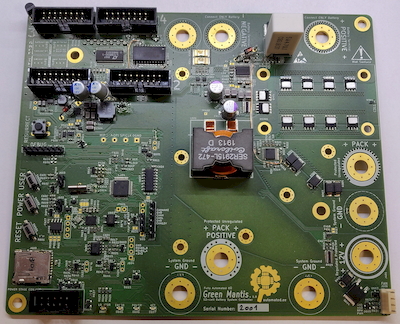
Battery Management System with auxiliary 12V/20A supply
Designed for the Akupakk project, and based on an earlier, exploratory design, Green Mantis was developed to match the requirements. It is based on the LTC6811 Battery Management IC and utilises a MSP430FR2355 for its control functions and data logging to a µSD card.
To power a Single-Board Computer and other peripherals, it has an auxiliary 12V/20A power supply. For communication it uses a TCAN4550 to provide a backwards-compatible CAN-FD interface. Furthermore to communicate with the Raccoon boards, it has RS-485 ports with IDC connectors.
Restless Raccoon
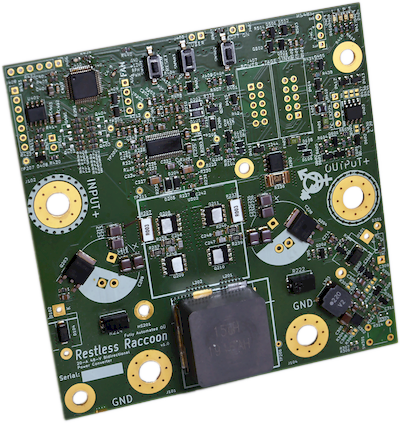
Bi-Directional DC/DC Converter
Requirements for the Akupakk included being chargable from a bus voltage which would be connected to the system. For this we developed the Raccoon boards. They are based on the ISL81601 four-switch buck/boost controller. They're also utilising a MSP430FR2355 to control the target voltage on the feedback pin. It uses RS-485 for communications and daisy-chaining and has Clock in/out to synchronise the phase-shift across all the available modules. Optionally it also has an axuliary supply (bottom-right corner in the picture) if it is not powered by the system and can be used as a standalone module.
Free-wheeling Ferret
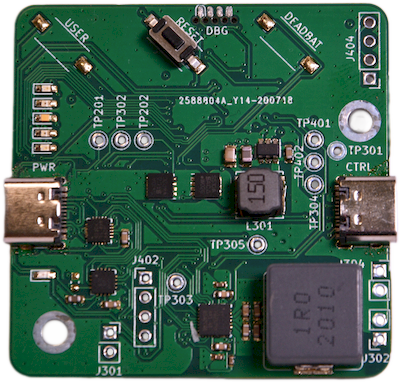

USB-C PD1 PPS2
A USB-C PD PPS multitool to use as a small bench supply or to charge your batteries or your devices on the go (even with MPPT).
The goal was to keep assembly costs and effort as low as possible, to provide an affordable solution with a very competitive featureset. We designed it so that we could produce small batches with an OpenPnP or LitePlacer or also by hand-placing the components on the front side. The back side is optimised to be assembled by JLCPCB using mostly just basic parts.
Luminiaire

Luminiaire is part of a larger, on-going effort to build electronics for small-scale horticulture. It started out initially as supplementary lighting for normal house plants because our workshop only has direct sunlight for a couple hours at most in summer.
The LED driver will be based on Canesys with a feature-set specifically tailored for plant lighting. It also ties into the larger concept of a 48V microgrid.
We also plan to build some additional hardware for e.g. soil moisture sensing and pump controllers for hydroponics and automated watering of plants.
CANesys

Canesys is a three string smart LED driver with CC/CV and up to 65V Vin. It is based around the STM32F072, speaks RS-485 and CAN to tie neatly in any DIY Home Automation system.
Means of Colorful Lighting
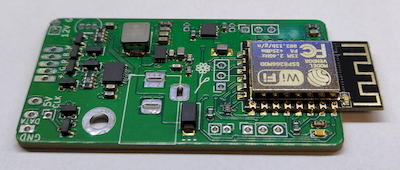 The Fully Automated MCL is a Wifi-enabled RGBW+Smart LED strip controller. It has a unique design: it can drive the cheaper, simple RGB(W) 12-volt LED strips, or the WS2812-based (and clones thereof) 5-V smart LED strips. If you drive a smart LED strip, you can supply the board with a wide range of input voltage: between 5 and 17 V. The necessary 5-volt supply for the LEDs is generated on-board with up to 3.5 A continous output. Because of this, you can use thinner wires and 12-volt power bricks with lower current output; the on-board converter is highly efficient.
The Fully Automated MCL is a Wifi-enabled RGBW+Smart LED strip controller. It has a unique design: it can drive the cheaper, simple RGB(W) 12-volt LED strips, or the WS2812-based (and clones thereof) 5-V smart LED strips. If you drive a smart LED strip, you can supply the board with a wide range of input voltage: between 5 and 17 V. The necessary 5-volt supply for the LEDs is generated on-board with up to 3.5 A continous output. Because of this, you can use thinner wires and 12-volt power bricks with lower current output; the on-board converter is highly efficient.
-
- Project status
- Version 2.0 complete, needs more testing and firmware
HiPPoL and other assorted DC/DC converters

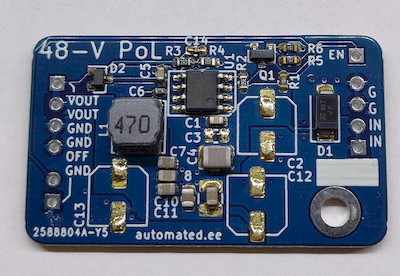
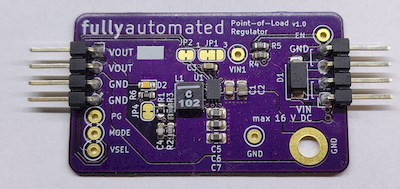

-
- HiPPoL (top left)
- 80V Vin max, 5/12/20V Vout 5A converter
-
- TinyPoL (top right)
- 85V Vin max, 5V Vout 1.2A converter, Silergy SY8501
-
- TPS62135 (bottom left)
- 17V Vin max, 5V Vout 4A converter
-
- ISOPoL (bottom right)
- 17V Vin max, 5V Vout, 1.5A converter based on the TPS62135